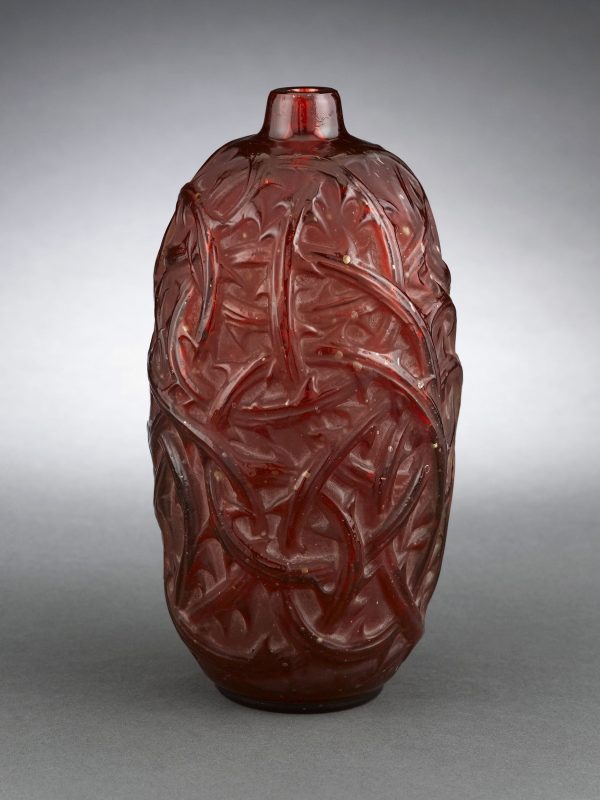
This stunning crimson art glass vase was created by the legendary René Lalique, circa 1913-21.
Entitled Ronces, the bold design is engulfed by thorny briars
Master of glass, jewelry designer, and creative genius… the talents and artistic mastery of René Lalique are both interminable and immortal. Born in rural France and educated in Paris and London, Lalique is celebrated as an integral part of the artistic revolution of the late 19th century in France. As a young, aspiring jewelry designer, Lalique came into his own during a period on the brink of a new artistic phenomenon: the Art Nouveau style. Beginning with the Paris Exhibition of 1900, the opulent, organic, and asymmetrical designs of the Art Nouveau movement skyrocketed in popularity about the Parisian fashion elite.

Elongated palm leaves create a dramatic raised motif upon this superb example of Lalique’s clean and elegant Art Deco style.
Producing his own unique twist on this chic new style, René Lalique secured a place as one of the leading Art Nouveau Renéjewelry designers of his age. Versatile, stunning, and revolutionary, Lalique’s outstanding creativity in design resulted in some of the most dazzling and original pieces ever seen. Ever versatile, Lalique began his first foray into the realm of glassmaking and design at this time as well, cementing his place as one of the most important designers of the period.
Purchasing a small glass making factory in 1909 in Combs, France, called “Verriere de Combs la Ville,” Lalique began crafting and designing stunning Art Deco glass perfume bottles, glass vases, and table decorations. He rapidly gained international recognition, by securing high profile clientele such as Sarah Bernhardt, and his popularity grew rapidly. Later, while expanded to larger workshops, he always remained the exclusive designer of all glass works. While his pieces catered to the tastes of the elite, Lalique strived to pay close attention to the likes of the European middle class in a strong desire to cater to all social classes. It is this technique that also characterized him as a strategic, brilliant businessman.
As the 19th century came to a close, the 20th brought with it a new, equally revolutionary style: Art Deco. It was the Exposition des Arts Decoratifs of 1925 that propelled the Art Deco artistic movement into the popular sphere. As Europe turned its attention to this new, architectural style, so too did Lalique successfully blend his unique style into the new Art Deco technique. In 1925, without a doubt, Lalique and his glass were one of the major stars of the Paris Exposition, securing his place as a premiere designer and innovator.

Foliate concentric circles are layered to form this rare Lalique vase entitled “Ferrières.”
As Lalique strongly adhered to the Art Deco movement, he also perfected the new press-molding techniques. With this, most of his vases had wide necks so that the plunger used to force molten glass into the mold could be easily removed. The result was an exterior with crisp, sharp lines and an interior that was perfectly smooth. This Biskra Vase, for example, depicts a very rare Lalique pattern of sharp, clean lines of elongated palm leaves. In a deep blue color, this vase is the epitome of the streamlined, geometric Art Deco style.
One of Lalique’s most famous Art Deco designs includes the Ronces motif. This Ronces Art Glass vase appears to have been woven from a tangle of thorny vines. While many of the Ronces patterned vases were translucent, our Ronces vase is crafted in a deep crimson color that was one of the most difficult to work with. The frosted body of the vase provides a stark contrast to the highly polished, stylized vines that cover the surface. The molded surface of the decorative Languedoc vase was a tight pattern of what look like stylized coleus leaves. This pattern is a perfect example of the pioneering design innovations that characterized Lalique’s career.
Like the unique Ronces pattern, this rich green decorative art glass vase features layered foliate concentric circles that form the elegant Ferrieres pattern. Like most Art Deco designs, this pattern shows formalized, bold shapes of strict symmetry. Speaking to its own uniqueness, this incredible vase is like no other.
View our entire Lalique Art Glass selection here



